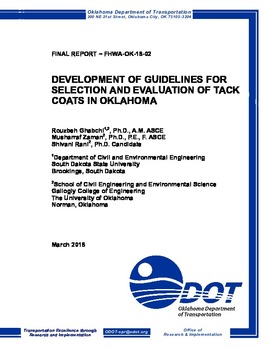| dc.description.abstract | Asphalt pavements are generally constructed by compacting asphalt mixes in multiple lifts to achieve the required density across thelayers. Also, depending on pavement preservation and maintenance plan, from time to time, a thin overlay may be constructed over anexisting asphalt pavement or a Portland Cement Concrete (PCC) pavement. The quality and integrity of the bond between asphaltlayers, especially the bond between the existing surface and an overlay, is crucial to pavement’s durability and serviceability. Inadequateinterlayer bond may lead to distresses such as half-moon-shaped cracks, delamination, longitudinal wheel path cracking, potholes,fatigue cracks, slippage, and rutting. In order to improve the interlayer bonding of asphalt pavements, and create a moisture barrier atlayers’ interfaces, tack coats are used. Tack coats improve the interlayer bond strength and help pavement layers behave as a singlecohesive system. This improves pavement’s resistance to traffic and environmental stresses. The interlayer bond strength is mainlygoverned by the selection of tack coat product and applying it at an optimum residual application rate (referred to as application ratein this report). The optimum application rate of a tack coat, to a great extent, depends on the existing pavement surface conditionssuch as new, old, or milled surface, tack coat type, moisture, and temperature. This study evaluated the effectiveness of tack coats usedby the Oklahoma Department of Transportation, namely SS-1, CRS-1, CBC-1H, CRS-1S, NTHAP, and NTQS-1HH with respect to theirtype and application rate, pavement surface conditions, moisture-induced damage, and temperature. Two test methods were used fortesting the tack coats: (i) Interlayer Shear Strength (ISS) of tack coat using the Louisiana Interlayer Shear Strength Tester (LISST); and (ii)Room-Temperature Tracking (RTT) test. Also, laboratory-compacted samples and a number of field cores from selected projects werecollected and tested selectively to evaluate the tack coat performance. Based on the test results, a database that can be implementedfor the selection of tack coat type and application rates was developed. Also, the optimum tack coat application rates, based on theirISS values was developed and presented that can be used for selection of the tack coats depending on pavement surface types. Also, asthe removal of the tack coat through tracking by the construction equipment is a concern, setting times of the tack coats werepresented that can be immediately implemented. Finally, a draft special provision was developed and included for improving thecurrent practice in using tack coats in construction of the asphalt pavements in Oklahoma. | |
